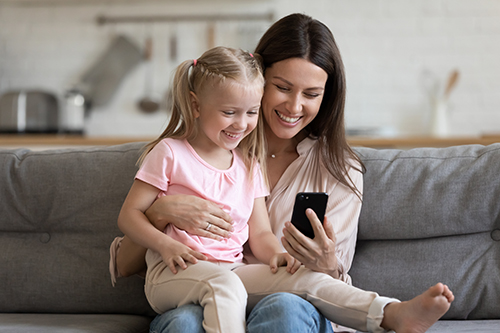Well Child: Staying Healthy at Home With Telehealth Care

What to know before your child’s virtual doctor’s visit
We’re following recommendations to stay healthy at home, but bumps, scrapes and sick days still happen. Thankfully, it’s never been easier to see a doctor without leaving home. As health-care providers and families adapt to COVID-19 and social distancing recommendations, more medical visits are taking place remotely via telehealth (also called “telemedicine” or “virtual care”).
Prior to COVID-19, telemedicine was already trending; virtual visits were projected to increase 16.5 percent by 2023, according to a report by Market Research Future consultants. Then, the coronavirus pandemic hit, and telehealth surged. In March 2020, telehealth visits spiked 50 percent.
The growth of telehealth in pediatric health care is good news for busy parents, many of whom are now juggling work and home-based schooling, says Nawal Alkharouf, M.D., a pediatrician with Washington-based health-care provider Pacific Medical Centers. “One of the main benefits we’re seeing for telehealth is convenience, especially in times like these. If families don’t want to come into the clinic or can’t make it in, this is another way to care for their child’s health,” she says.
Virtual care works best with your regular doctor.
Although telehealth can work well in urgent-care scenarios or help people who don’t have a regular primary care provider, it works best in an established doctor-patient relationship, says Dr. Alkharouf. “Telehealth is most beneficial if it’s your own pediatrician or someone who has seen the child before, because that provides the greatest continuity of care,” she says.
Some conditions are better suited to virtual care than others.
Virtual visits work particularly well for certain types of pediatric care — for example, managing some chronic conditions, such as asthma and diabetes; follow-up appointments; behavioral health; and mild cold and flu symptoms. Other situations, such as a suspected ear infection or broken bone, warrant an in-person visit. “Telehealth doesn’t work for every condition or all situations. If the provider needs to look into the child’s ear to diagnose an ear infection, they’ll likely need to go in,” says Dr. Alkharouf.
You don’t need any special equipment (but some advance prep won’t hurt).
There’s no need to buy an otoscope, a special thermometer or any other medical equipment for a virtual well-child visit, says Dr. Alkharouf. But taking 10–15 minutes to prepare for an appointment paves the way for a productive virtual session. Check your email or your provider’s online patient portal for instructions, complete any screening questionnaires, update your child’s health history (including making a list of all specialists or other health-care providers your child sees and assembling any medications), fill in insurance and pharmacy information, and make a list of questions or concerns you would like to discuss with the doctor. In preparation for the visit, take basic measurements (height and weight, and head circumference for children age 2 and younger) and check vital signs (temperature, pulse rate).
Your provider still wants to ‘see’ your child.
“Telehealth” can be a misleading term, since most virtual visits include a video component. And even though your provider may be miles away, they still want to get a good look at your child. For video visits, find a quiet spot in the home with good lighting so your provider has a clear view of your child. “For babies and small children, placing your laptop or device on a bed can work well,” says Dr. Alkharouf.
You may still need an office visit.
A sick-child appointment (say, for a rash or pink eye) can probably be carried out completely online. But a well-child visit may have two components: Caregivers can complete screening questionnaires and other paperwork virtually, then come in later for a physical exam and vaccines. “A good physical exam is an important part of a well-child visit, so it is important to bring your child in,” says Dr. Alkharouf. “But the good news is that you don’t necessarily need to come in right away unless your child needs a vaccine right now. So, you could do the virtual component of the exam now and wait until the summer, once things have calmed down with the pandemic, to come into the office.”
Behavioral health care at home has special considerations.
Behavioral health care can work well via telehealth since it usually doesn’t require a physical exam and can be easily carried out via video phone or video chat. But virtual health care makes it harder for providers to ensure patient privacy, an essential component of behavioral health. “Privacy is a major concern for behavioral health care at home, especially for our adolescent patients,” says Dr. Alkharouf. “If a private bedroom isn’t an option, some families have their teenager do their virtual health care in their car, so [the teen] can have complete privacy.”
Even after social distancing ends, telehealth will keep growing, says Dr. Alkharouf. “PacMed just launched virtual pediatric care, and the response from parents has already been very positive. Parents appreciate that they can take care of their child’s health, keep them safe and save time.”
Coping with loss and grief during COVID-19
If you are feeling lethargic, sad, distracted, disinterested in things you enjoy, or irritable—you may be grieving. There can be power in identifying that emotion.
 Having lived with the coronavirus pandemic for several months now, you may have noticed changes in your emotional state. While many of my patients were experiencing deep fear, anxiety or panic in February, today you may find yourself suddenly in tears, emotionally distracted, or feeling angry or depressed. Or even just struggling to recall a common word or jumbling sentences. These are all signposts on the very human path of grief and mourning.
Having lived with the coronavirus pandemic for several months now, you may have noticed changes in your emotional state. While many of my patients were experiencing deep fear, anxiety or panic in February, today you may find yourself suddenly in tears, emotionally distracted, or feeling angry or depressed. Or even just struggling to recall a common word or jumbling sentences. These are all signposts on the very human path of grief and mourning.
With the COVID-19 pandemic has come great loss. You or someone close to you may have lost a friend or family member to COVID-19. Loss during the pandemic comes in many other forms, too, such as the loss of connection with friends and family, the loss of touch, and the losses of safety, economic stability and a known future. Each of these is significant in itself; most people are processing a combination of many losses at once. David Kessler, an expert on grief, commented recently in the Harvard Business Review, “This is hitting us and we’re grieving. Collectively. We are not used to this kind of collective grief in the air.”
Although grief is universal, it expresses itself in many different ways. It can be hard to know what to say or how to act to support a loved one who may be struggling. And it can be easy to overlook your own mourning and be gentle with yourself.
Here are a few ways to honor and provide support to yourself and those around you who are grieving a death or other type of loss:
Be present. You usually can sense when something is bothering a loved one. Without pestering, it’s important to let them know that you are available to them. When they are ready to talk, respect their vulnerability and turn off your phone or the TV to show them you are there with them, to listen or just be. At the same time, if you notice changes in your own mood or outlook, slow down and take stock of the big picture. It’s natural to feel things in response to such widespread change. Give yourself space and permission to feel them.
Name your grief and reach out to others. You may feel like you need to put on a strong face for others who are struggling. But it’s more healing to be vulnerable and acknowledge that you are affected, too. By sharing your experience, your loved one will know that they are not alone and will feel less isolated during this challenging time. It’s ok to ask for the support you need.
Find new ways to celebrate a loved one’s life. Recognize that although you may not have been able to be with a loved one during their last moments, you can grieve together with family and friends. The fact that we can be connected virtually with family and friends is important. Create a collaborative video: ask friends and family to share funny, significant or other memories by posting a picture with audio about what it meant to you. Make plans for a future memorial service, for when everyone may be able to come together again. Use an online obituary service to share your loved one’s life story, and to exchange memories and condolences. Even during this time, it is important to create a shared experience to honor the death and each other’s relationships.
Move toward acceptance and inner calm. For a long time, mental health professionals have recognized that grief has some distinct elements: denial, anger, bargaining, sadness and, with time, greater acceptance. David Kessler, who worked with Elisabeth Kübler-Ross to define these stages of grief, reminds us that, “Acceptance… is where the power lies. We find control in acceptance. I can wash my hands. I can keep a safe distance. I can learn how to work virtually.” By focusing on activities that you can control, you can enter the present, open up to creativity, and build acceptance.
Being in the present is also calming. Take 30 seconds and listen, deeply, to the sounds in your home or outside a window. Take a moment each evening to express gratitude for life’s small treasures: a generous neighbor, a healthy meal, a hand to hold, music you love. If you’re feeling sad or frustrated, don’t fight it: let the emotion be there with you. When you acknowledge your emotions rather than fighting them, your relationship to the feelings—and the loss—can transform over time.
If your emotional state becomes overwhelming, don’t hesitate to reach out to a mental health professional who can help guide you through your experience of grief. You are not alone, and getting the help you deserve is part of the path of living through loss.
Read more of PacMed’s resources during COVID-19.
Maintaining eye health during telecommuting

During this time of increased computer work and digital communication, it is important to be mindful of eye strain and give yourself regular breaks. This is why Pacific Medical Centers, recommends the 20-20-20 rule. Specifically, for every 20 minutes you look at a screen, look away for 20 seconds at something that is 20 feet away.
Dr. Kernie at Pacific Medical Center also recommends the following preventative steps to minimize eye strain, especially during this time of working from home. Trying incorporating the following tips:
- If you have prescription eyewear, ensure that you’re wearing them
- If you get dry eyes, remember to drink water, and use artificial tears for additional moisture (not red-eye or allergy drops, as those are for different uses)
- Try to avoid glare from windows or indoor lights
- Adjust your computer screen so the top of it is level with your eyes
- Choose a comfortable and supportive chair
- Don’t forget to blink – not blinking enough can cause red, irritated, dry eyes
Those who do most of their work on computers are most at-risk of eye strain due to the visually demanding nature of digital screens. Additionally, those who are farsighted, have astigmatism or who have problems using their eyes together have a greater risk of eye strain and may require prescription glasses or eye exercises to help manage their eye strain.
It’s also important to drink plenty of water and eat a nutritious diet which includes foods that are good for the eyes. These can include green leafy vegetables (spinach, swiss chard or kale), oily fish, eggs, legumes, nuts, and beans. Green leafy vegetables all have high amounts of Lutein and Zeaxanthin which appear to prevent or slow down macular degeneration and cataract formation.
Foods rich in omega-3 oils such as salmon, oysters, and ground flax seeds, are good for the retina and for the meibomian glands in the eyelids (the oil glands near the eyelashes next to the eyeball that produces part of the tears).





